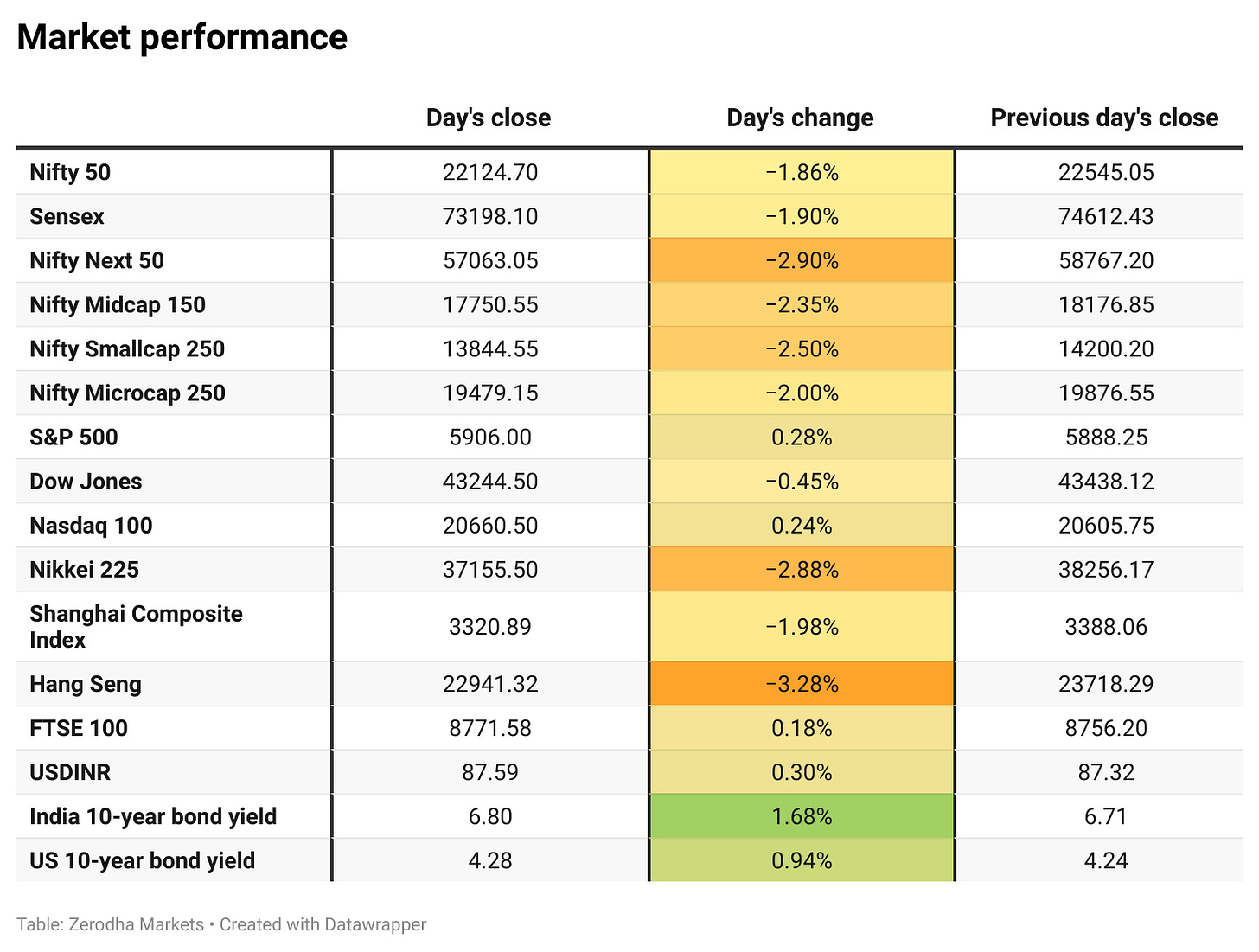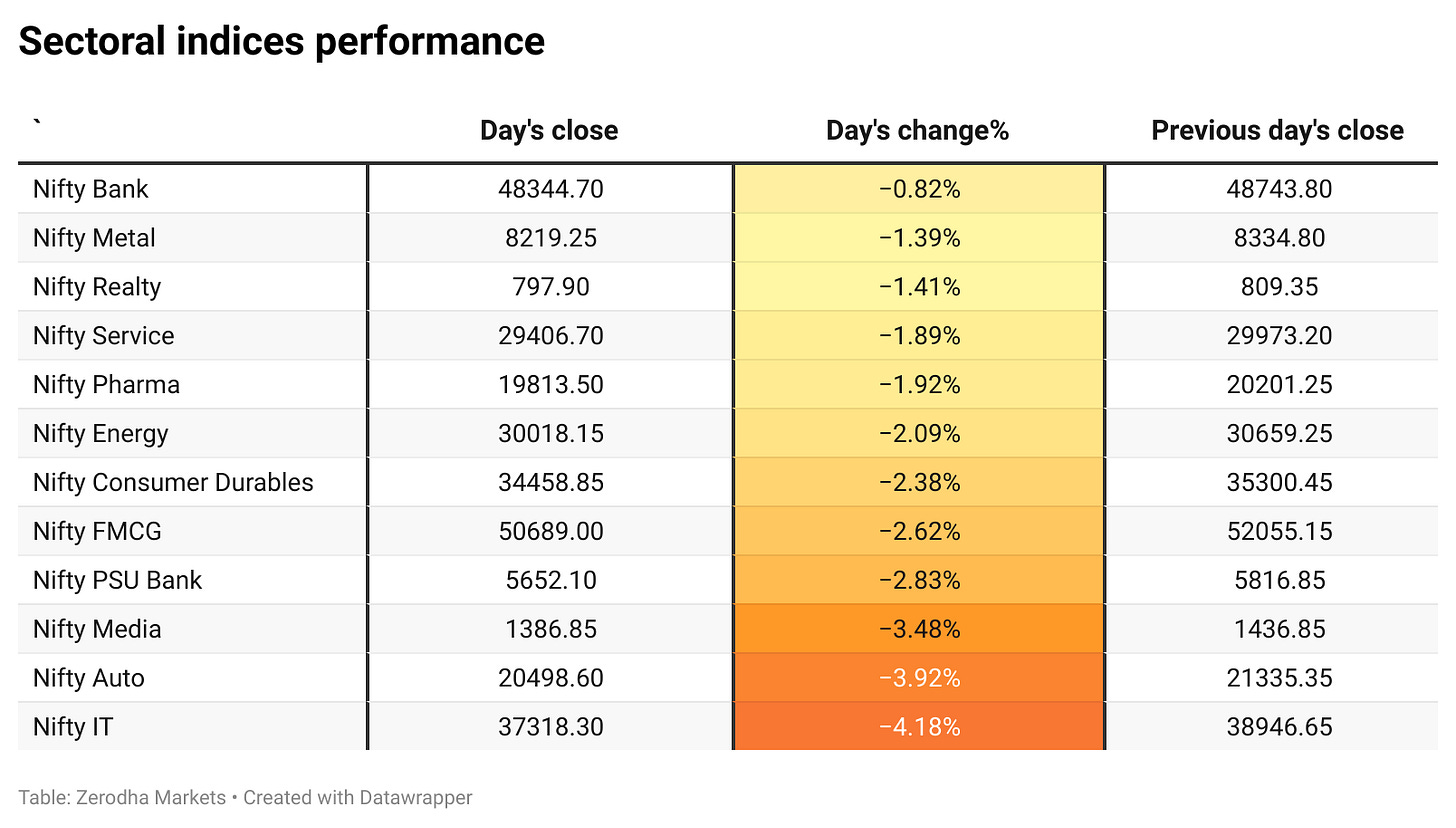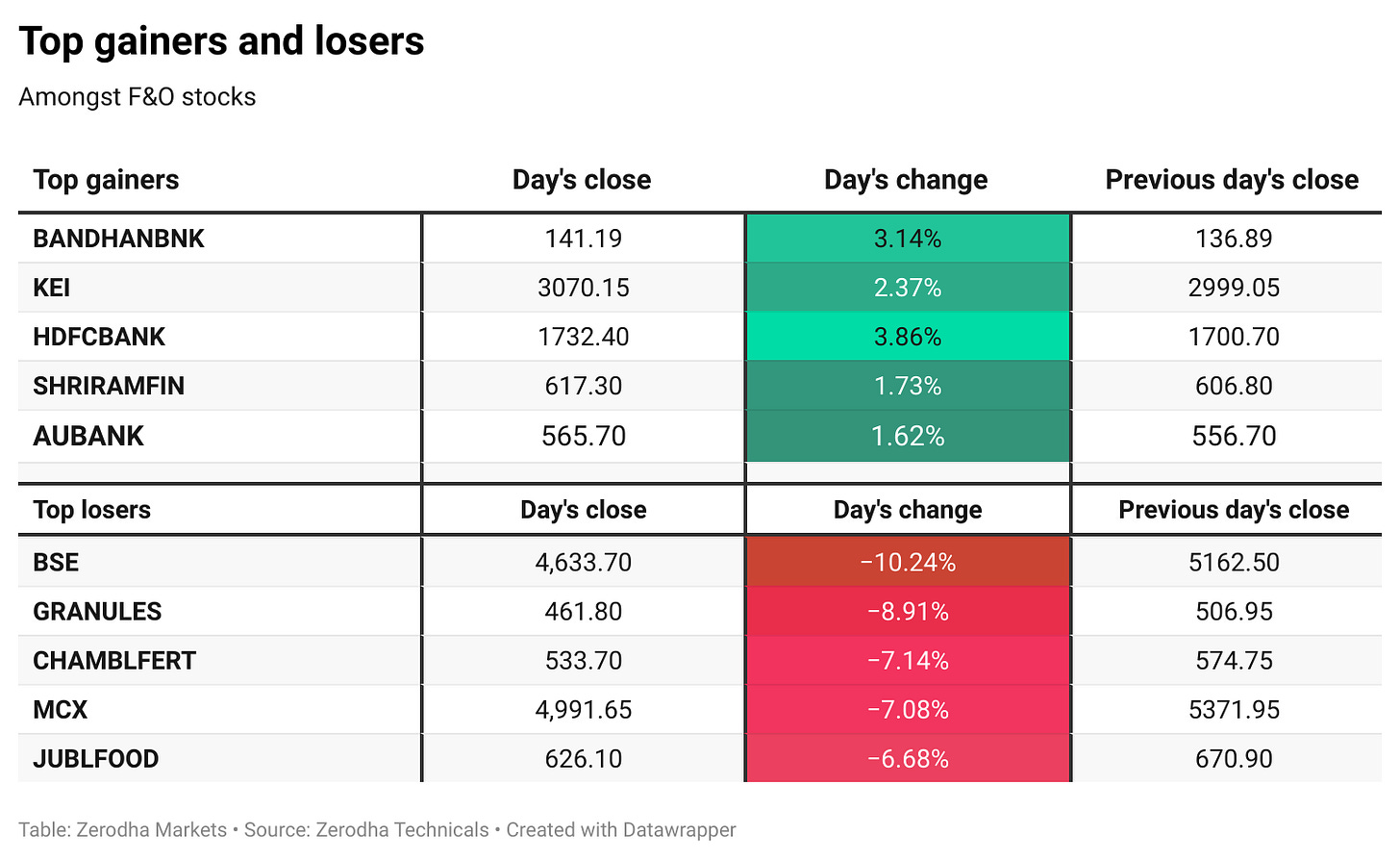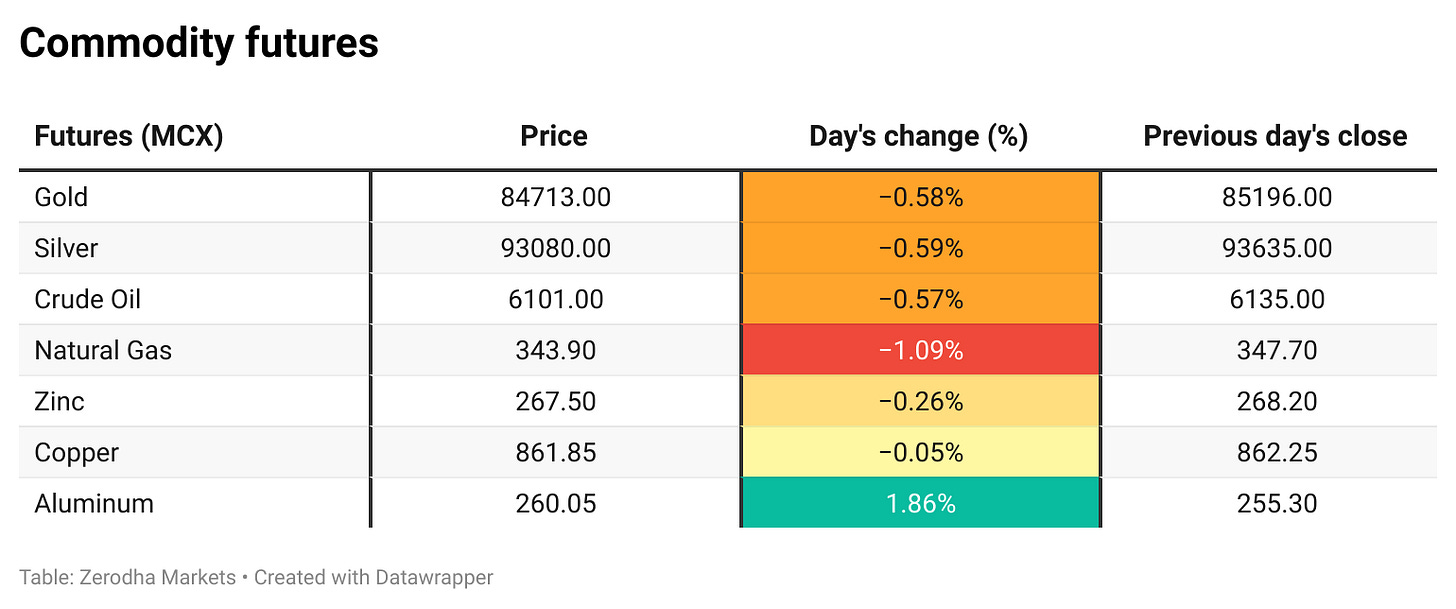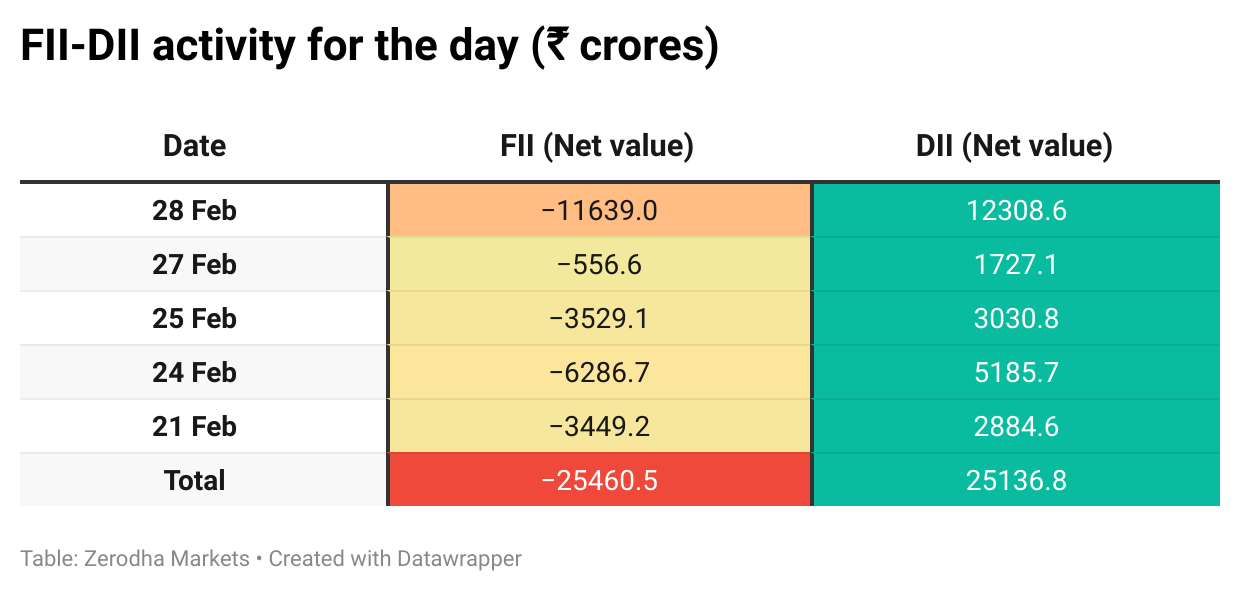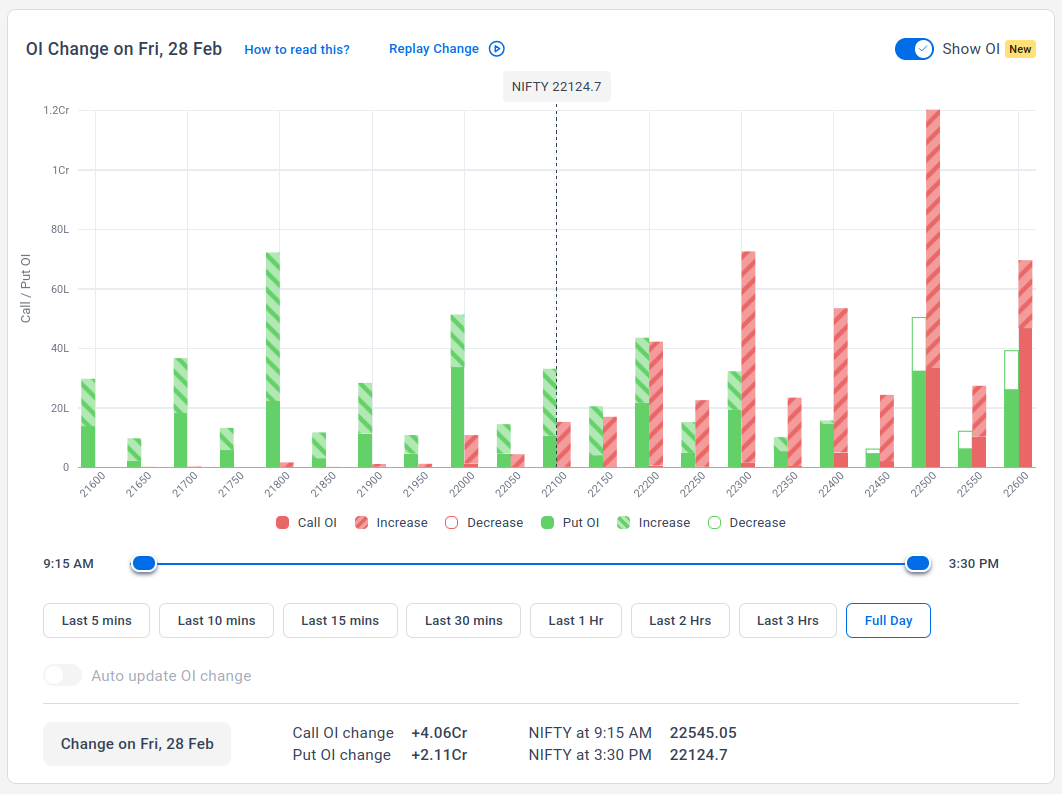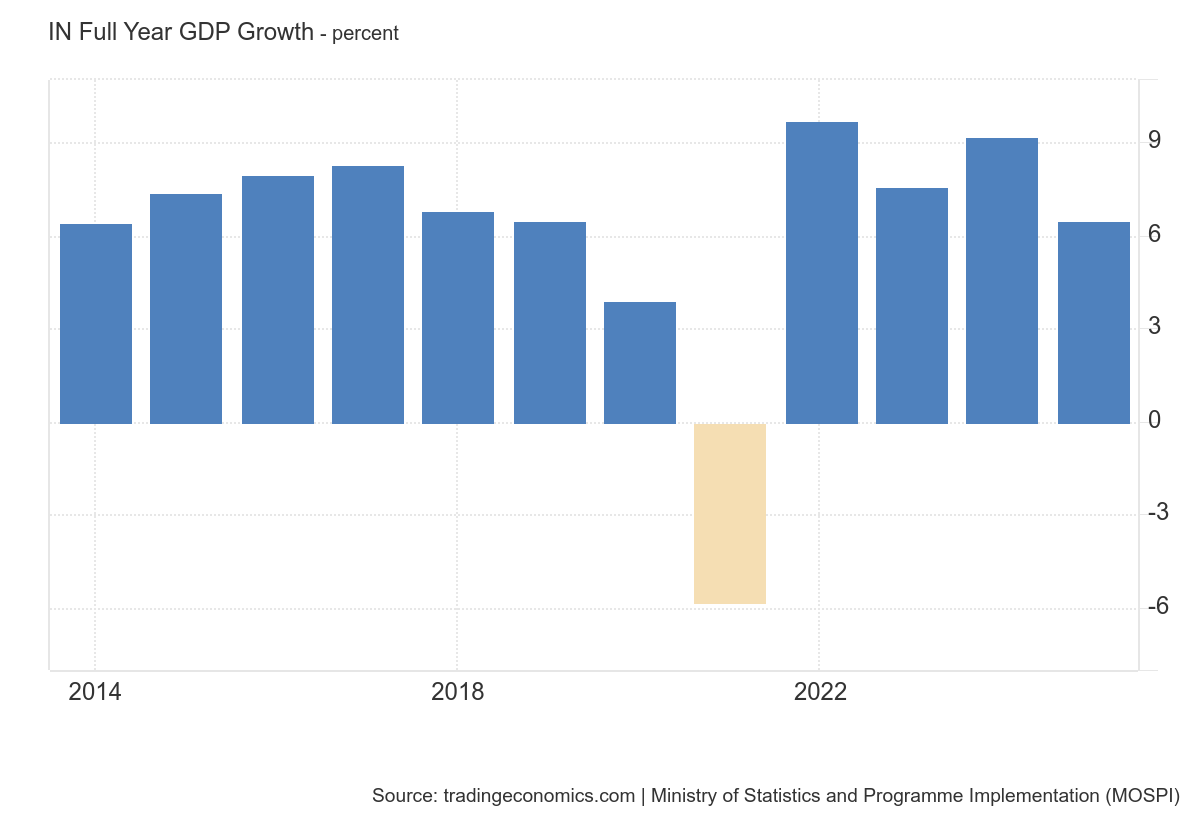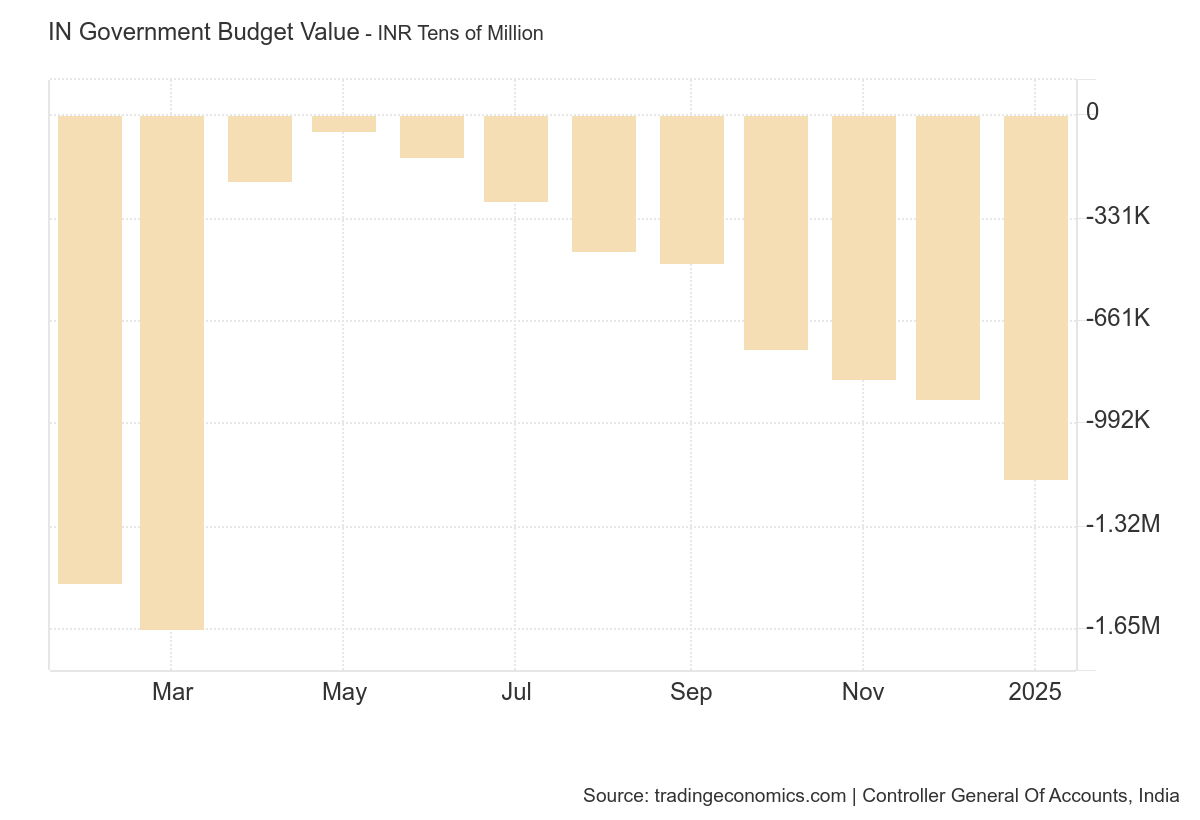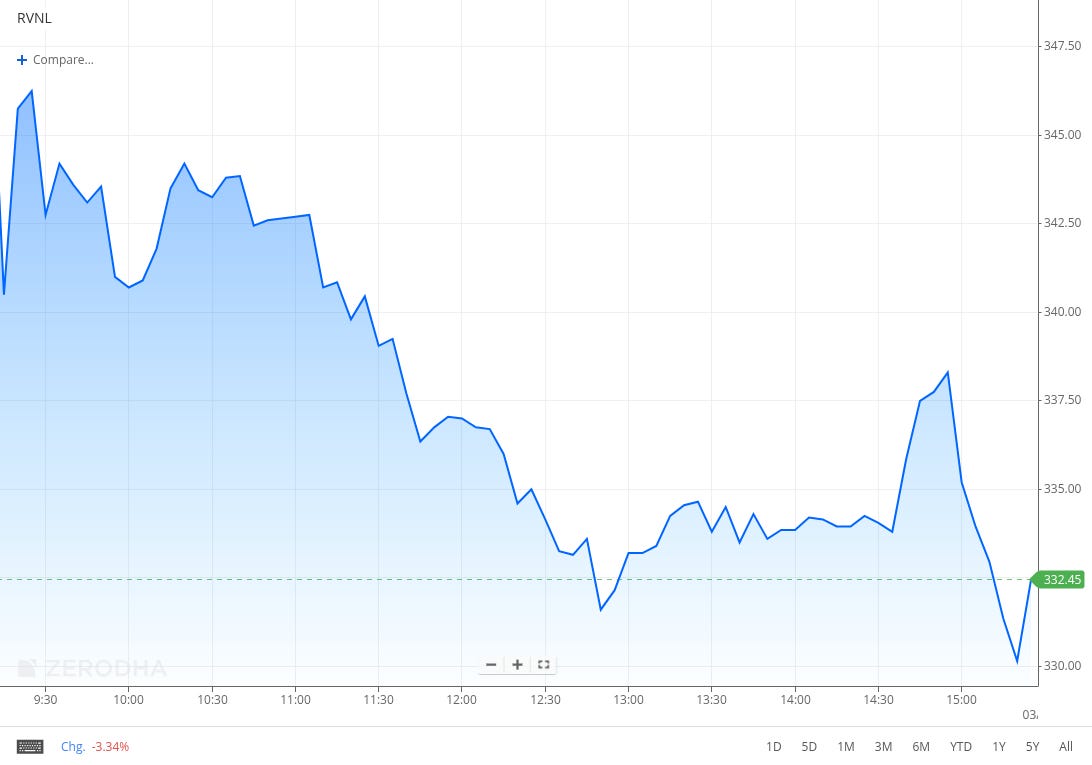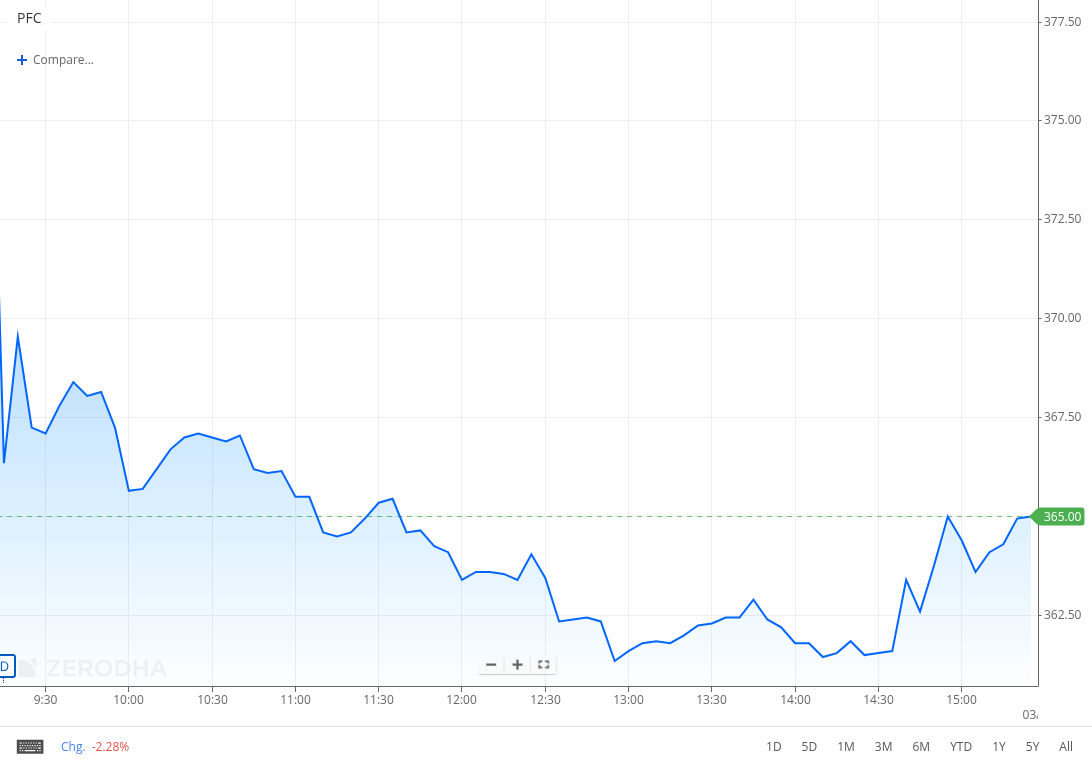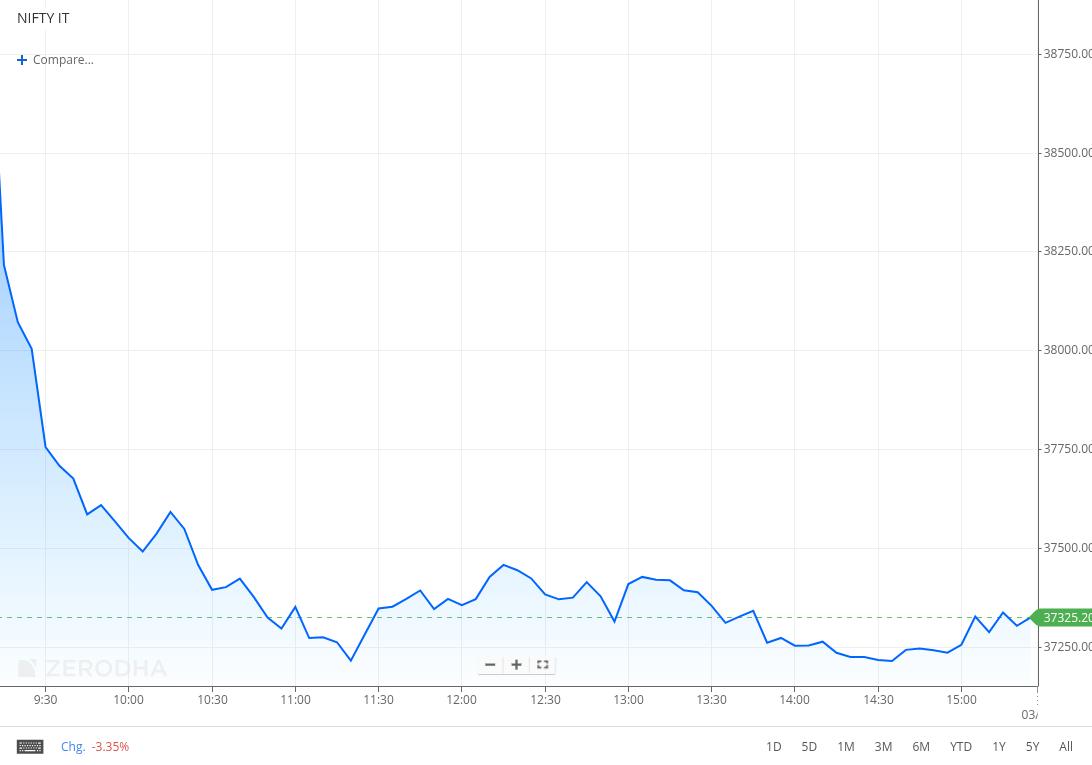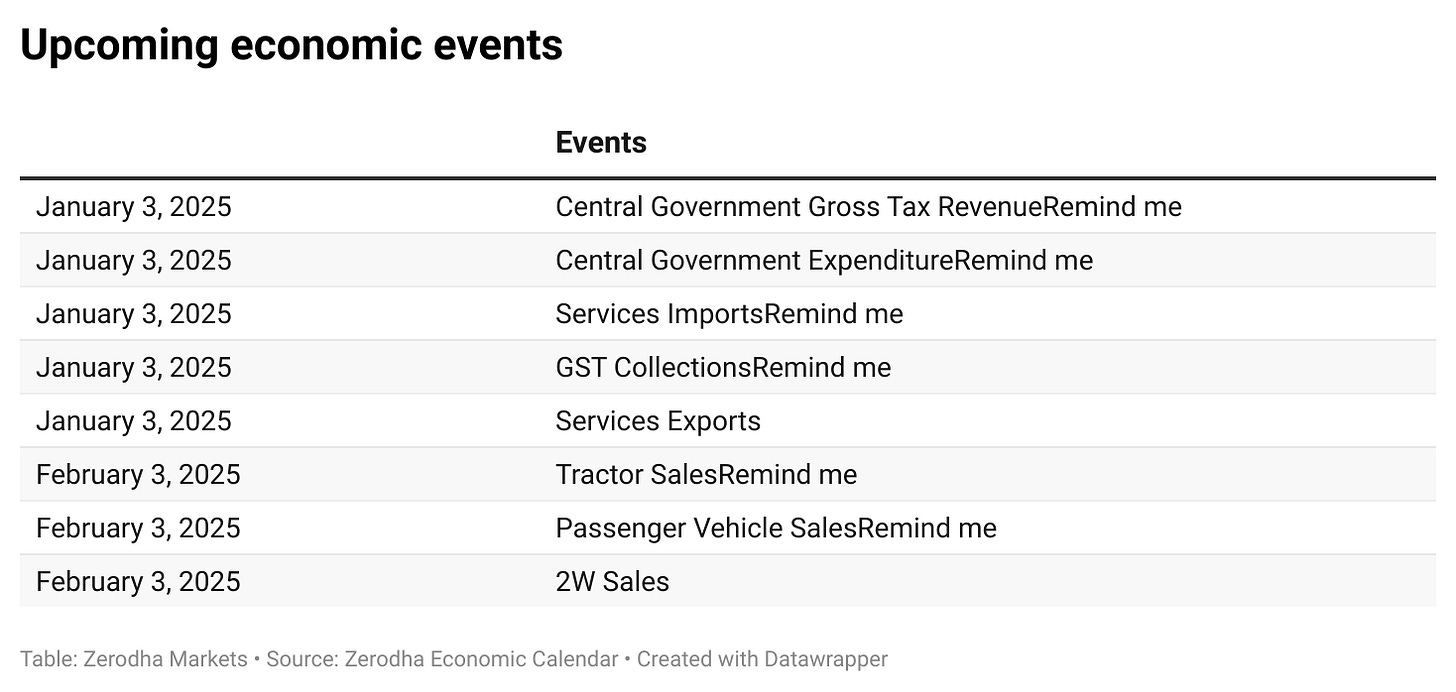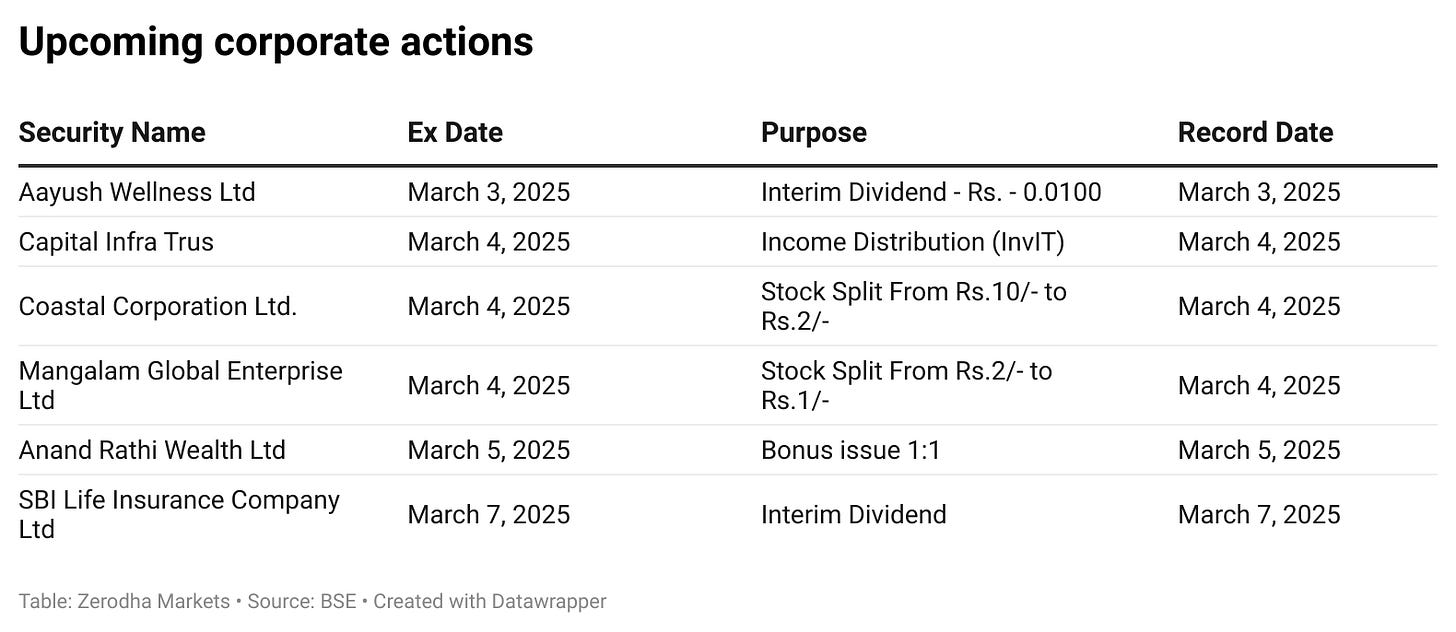Nifty opened 112 points lower at 22,433.40, tracking weak global cues, and continued to slide throughout the day, slipping below key levels of 22,400 and 22,300 in the first hour. It then remained within a narrow 50-point range for the next two hours before plunging further, hitting a low of 22,105. Despite a 75-point recovery in the final hour, the index closed at 22,124.70, down 1.86%, marking its worst February decline since 2020 and biggest fall in five months.
With India’s GDP growth coming in at 6.2%, it remains to be seen whether the weak sentiment stabilizes at these lower levels or continues the downtrend seen over the past five months. Market sentiment remains cautious due to FII outflows and tariff concerns.
Broader Market Performance:
The broader market saw further deterioration in breadth, with declining stocks outnumbering advancers. Of the 2,972 stocks traded on the NSE today, 490 advanced, 2,414 declined, and 68 remained unchanged.
Sectoral Performance:
Nifty Bank was the least impacted sector, posting a modest decline of 0.82%. In contrast, Nifty IT suffered the steepest drop, closing 4.18% lower, making it the worst-performing sector of the day.
All 12 sectors ended in the red, signaling a broad-based sell-off across the market. With no sector managing to close in positive territory, the session reflected a strong bearish sentiment.
Note: The above numbers for Commodity futures were taken around 4 pm.
Net Flow Breakdown for the day:
- FII: Net outflow of ₹11,639.02 crore (Bought ₹39,239.44 crore, Sold ₹50,878.46 crore)
- DII: Net inflow of ₹12,308.63 crore (Bought ₹28,065.55 crore, Sold ₹15,756.92 crore)
Change in OI for the day
The following is the change in OI for Nifty contracts expiring on 6th March:
- The maximum Call Open Interest (OI) is observed at 22,500, followed by 22,300, indicating strong resistance at these levels. First strong resistance levels shall most likely be at 22,300, followed by 22,500.
- The maximum Put Open Interest (OI) is at 21,800, followed by 22,000, suggesting potential support at 22,000, with additional support at 21,800.
Note: OI is subject to multiple interpretations, but generally, an increase in the call OI indicates resistance in a falling market, and an increase in the put OI indicates support in a rising market.
Source: Sensibull
Tijori is an investment research platform, and they have constructed niche indices for various themes and sub-sectors. They help you understand the market performance of narrow slices of the market. You can also track the Promoter buying and other interesting stuff like Capex activity by the companies in the Tijori App’s idea dashboard.
What’s happening in India
India’s GDP is expected to grow 6.5% in FY 2024/25, slightly above the initial 6.4% estimate, marking the slowest pace since the Covid recession. The slowdown is driven by higher energy prices, slower growth in Asian economies, and tight liquidity due to RBI’s restrictive monetary policy. Dive deeper
India’s fiscal deficit widened to INR 11.7 trillion in April-January 2024-25, reaching 74.5% of the full-year target. Expenditure grew by 6.4%, while receipts rose 6.6%. The government aims to reduce the fiscal deficit to 4.4% of GDP by 2025-26 and shift to a debt-to-GDP ratio benchmark by 2026-27. Dive deeper
Tuhin Kanta Pandey has been appointed the new chairman of SEBI, replacing Madhabi Puri Buch. An IAS officer from Odisha, he previously served as Finance Secretary and played a key role in disinvestment and the privatization of Air India. His tenure as SEBI chief begins with a three-year term. Dive deeper
Sebi will allow asset managers with a 3-year track record to offer Specialized Investment Funds (SIF) starting April 1, 2025. The funds will accept investments of ₹10 lakh or more, with strategies in equity, debt, and hybrid categories. This new asset class sits between PMS and mutual funds, targeting higher-risk investors. Dive deeper
RVNL won a Rs 136-crore contract from Central Railway for the Bhusaval-Khandwa section, focused on enhancing freight capacity with traction substations and posts. The project is expected to be completed in 24 months. Dive deeper
LIC received a ₹480 crore GST notice for FY21 from Maharashtra tax authorities, including dues, interest, and penalties for wrong input tax credit claims, with no material impact on its financials or operations. Dive deeper
Sebi has launched Bond Central, a centralized portal for corporate bonds, offering detailed risk assessments, bond documents, and comparisons with Government Securities. This free-to-access platform aims to enhance transparency and facilitate informed decision-making for investors. Dive deeper
PFC signed a Rs 26,800 crore financing deal to support Madhya Pradesh’s power utilities, funding projects like solar plants, thermal units, and infrastructure upgrades. Dive deeper
India’s gold jewellery exports to the U.S. could drop 50% due to potential tariff hikes, leading to job losses, warns a GJEPC study. Manufacturers may shift production to Oman and UAE to benefit from lower tariffs. The study calls for policy interventions to maintain India’s market position. Dive deeper
India’s air passenger traffic rose 11% in January 2025, reaching 1.46 crore. IndiGo maintained dominance with a 65.2% market share, while Air India saw the largest market share increase to 25.7%. Dive deeper
The World Bank urges India to accelerate reforms to reach high-income status by 2047, requiring 7.8% annual growth. Key focus areas include boosting investment, labor force participation, and productivity. The report emphasizes inclusive growth and targeted state-level strategies. Dive deeper
IHCL has teamed up with Goa’s Ministry of Skill Development to launch a hospitality skilling centre, offering training in key hospitality sectors. The initiative aims to boost employability and support Goa’s tourism industry. Dive deeper
The Asian Development Bank approved a $200 million loan to enhance climate-resilient sewerage and drainage infrastructure in Kolkata. The project aims to improve living conditions and health outcomes for vulnerable groups, addressing urban flooding and hygiene issues exacerbated by climate change. Dive deeper
Shares of Indian IT companies fell up to 6% amid concerns over a slowing U.S. economy, rising inflation, and Trump’s tariffs. The Nifty IT index dropped over 4%. Dive deeper
Coal India will impose an additional charge of ₹300 per tonne for coal from its subsidiary Northern Coalfields Ltd. starting May 1, 2025, expected to generate ₹3,877.50 crore in additional revenue. Dive deeper
India’s private consumption grew 7.2% CAGR, reaching $2.1 trillion in 2024, and is set to become the world’s third-largest consumer market by 2026. This growth is fueled by rising incomes, Gen Z preferences, and digital adoption. Discretionary spending and premiumisation are reshaping consumer behavior. Dive deeper
EPFO has decided to retain an 8.25% interest rate on EPF deposits for 2024-25, pending Ministry of Finance’s approval. This follows a previous hike from 8.15% for the 2023-24 fiscal year. Dive deeper
Ola Electric sold 25,000 scooters in February, but only 8,390 were registered due to contract renegotiations with vendors handling vehicle registrations. The company stated the discrepancy would be temporary, with no change in sales figures. Dive deeper
What’s happening globally
Brent crude oil futures fell to $73 per barrel, heading for its biggest monthly drop since September, as US economic concerns and market uncertainty impacted energy demand. Hopes for a Ukraine peace deal and Trump’s tariffs on China weighed on prices. However, sanctions on Venezuela and Iran limited losses. Dive deeper
The dollar index stayed around 107.3, supported by President Trump’s tariff announcements, including 25% on Mexico and Canada and 10% on Chinese goods. Despite the rally, concerns over economic slowdown and rising jobless claims led markets to price in potential Fed rate cuts. Dive deeper
US PCE inflation is expected to rise 0.3% in January 2025, with core inflation at 0.3%. Headline inflation is anticipated to ease to 2.5%, while core inflation may drop to 2.6%. The Federal Reserve revised its 2025 inflation forecast upward. Dive deeper
UK house prices rose 3.9% year-on-year in February 2025, slightly below January’s 4.1%, but above forecasts. Monthly growth reached 0.4%, surpassing expectations. Housing market activity remains strong, with a 14% rise in transactions in H2 2024 despite affordability challenges. Dive deeper
France’s inflation slowed to 0.8% in February 2025, driven by a significant drop in energy prices. Inflation eased in services, transportation, and tobacco, while food prices rose slightly. The EU-harmonized inflation rate fell to a four-year low of 0.9%. Dive deeper
Georgia’s economic activity grew 11.1% year-on-year in January 2025, up from 6.7% in December. Key contributors included transportation, construction, manufacturing, and trade. The mining sector saw a decline. Dive deeper
The Eurozone’s 12-month inflation expectations dropped to 2.6% in January 2025, from 2.8% in December. Three-year expectations remained at 2.4%. Inflation uncertainty stayed low for the sixth consecutive month. Dive deeper
Italy’s inflation rose to 1.7% in February 2025, up from 1.5% in January. Regulated energy prices saw a significant increase, while transportation and cultural services inflation eased. Core inflation remained unchanged at 1.8%. Dive deeper
Japan’s industrial production fell 1.1% month-over-month in January 2025, driven by declines in production machinery, electronics, and electrical machinery. This marked the third consecutive monthly drop. However, year-on-year production grew by 2.6%, reversing a previous decline. Dive deeper
Finland’s economy contracted 0.2% quarter-on-quarter in Q4 2024, revised from 0.1% growth, due to weaker household consumption. Government spending rebounded, and net trade positively contributed to GDP. On an annual basis, the economy grew by 1.2%, marking the strongest growth since Q2 2022. Dive deeper
Turkey’s GDP grew 3% year-on-year in Q4 2024, driven by stronger household consumption, government spending, and fixed investments. However, net trade weighed on growth, with exports falling and imports rising. Dive deeper
Microsoft’s Brad Smith urged the Trump administration to ease AI chip export curbs, warning it could push key markets toward China. The Biden-era rule restricts exports for AI model training. Smith expressed concerns about China’s technological advantage. Dive deeper
Management chatter
In this section, we pick out interesting comments made by the management of major companies and policymakers of the Indian and Global Economy.
Dr. Niranjan Hiranandani, MD of Hiranandani Group
- Seeing 10-12% growth in volume across the board for real estate sectors.
- Affordable housing was 40% of overall sales in 2020, now at just 20%, which is a negative.
- Luxury & mid-segment are growing faster than the affordable segment. - Link
Saugata Gupta, CEO of Marico
-
Rural demand is improving, worst for urban consumption is over; see gradual improvement over the next few quarters.
-
Food, premium personal care & digital brands are 21% of company’s revenue, up from 6% in 2020.
-
Actively de-risked company from commodity cycles.
-
Three years from now, the foods portfolio will be bigger than edible oil; confident of double-digit revenue growth for the next two quarters. - Link
Calendars
In the coming days, we have the following significant events and corporate actions:
That’s it from us. Do let us know your feedback in the comments and share it with your friends to spread the word.

